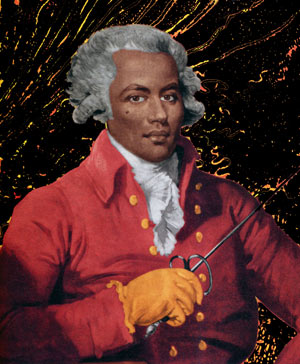BY RUNOKO RASHIDI*
The history of African people is so vast yet so spectacular, that one hardly knows where to begin. And this is not just the history of nations and kingdoms and communities, but of outstanding individuals—of great men and women. One of the most extraordinary of these individuals comes to us in 18th-century Europe, and he draws our attention like a powerful magnet. His name is Joseph Bologne, known to history as the Chevalier de Saint-Georges.
In an essay entitled “The Chevalier de Saint-Georges,” Edward Scobie documented the life of the African French composer, conductor, violinist, swordsman, equestrian and soldier, one of the most remarkable figures of the 18th century. Incredibly, this son of an enslaved African woman, Nanon, widely considered the most beautiful woman on the island of Guadeloupe, and a father who was a member of a wealthy family from the French Caribbean colony of Guadeloupe. He rose to the top of French society through his mastery of fencing and his genius for classical European music. His diverse career is immortalized in the famous portrait painted in 1787 by the American artist, Mather Brown in London. In the portrait, Saint-Georges is dressed for a concert but holds a sword in place of a conductor’s baton.
Joseph Bologne, who was to become the Chevalier de Saint-Georges, was born on Christmas Day, 1745 and moved to France in 1755. In spite of his father’s status, Saint-George’s African heritage made him ineligible for the nobility and its titles under French law. Eventually, legal or not, he took the titles anyway. This was the age of Enlightenment in France and yet philosophers like Voltaire were among those that argued that Africans were genetically inferior to Europeans.

Because of his father’s wealth and status, St. Georges received the advantage of a superior education. At age 13, he entered an elite fencing academy and boarding school. Mornings at the academy consisted of classes in mathematics, history, foreign languages, music, drawing, and dance. Afternoons were devoted to the fencing. One of his classmates wrote that Saint-Georges was the most extraordinary man of arms ever seen. Eventually he would be called “the god of arms.”
In all things athletic he seemed to excel. He could often be seen swimming across the River Seine with only one arm, and in skating, his skill exceeded all others. As to the pistol, he rarely missed his target. In running, he was reputed to be one of the leading exponents in the whole of Europe.

By 1778 Saint-Georges had reached his professional peak as a composer. He published two symphony concertantes in 1776 and two more in 1778. In 1777 he wrote three violin concertos and six string quartets. Some people call Saint-Georges the Black Mozart. Early in 1779 Saint-Georges began performing music with Queen Marie-Antoniette at Versailles, at her request. He was one also of the first Black Masons in France.
Saint-Georges’ trips to England introduced him to the anti-slavery movement. Eventually he helped found a French group called the Société des amis des noirs (Society of the Friends of Black People). Saint-Georges’ support for the liberation of enslaved Africans was well known in England, and was no doubt irritating enough to warrant Britain’s slave cartel’s attempts on his life.

Saint-Georges lived alone in a small apartment in Paris during the last two years of his life. In late spring, 1799 an untreated bladder infection caused him to become weak and feverish. He died on June 10, 1799 (the year that Alexandre Pushkin was born). The newspapers celebrated his memory with respect and emotion. Since 1912 a street in Guadeloupe bears his name. In December 2001 the Paris City Council voted to change the name of a Paris street name from Rue Richepance to Rue du Chevalier de Saint-George.
*Runoko Rashidi is a noted historian, a world traveler and the author or editor of several books. Among his most recent works are Black Star: The African Presence in Early Europe, in 2012, and African Star over Asia, in 2013. Rashidi is currently coordinating African heritage TOURS! to many parts of the world. For more information please write to [email protected] or go to his web site at www.travelwithrunoko.com



